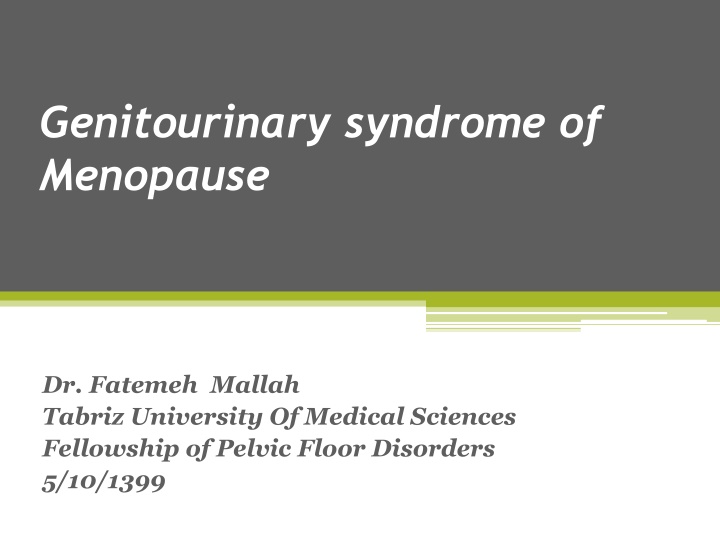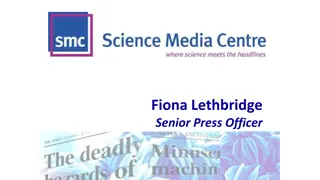Career Path to Statistics & Important Skills for Statisticians
As a Senior Principal Biostatistician at Janssen R&D Johnson & Johnson, Jessica A. Behrle shares insights on the fascinating world of statistics. Discover the journey to becoming a statistician, the essential skills required, diverse job opportunities in nonclinical statistics, and the intriguing work involving photoreceptor cell measurements in a rat's eye. Gain valuable knowledge on the significance of statistics and the impactful role statisticians play in various industries.
Download Presentation

Please find below an Image/Link to download the presentation.
The content on the website is provided AS IS for your information and personal use only. It may not be sold, licensed, or shared on other websites without obtaining consent from the author.If you encounter any issues during the download, it is possible that the publisher has removed the file from their server.
You are allowed to download the files provided on this website for personal or commercial use, subject to the condition that they are used lawfully. All files are the property of their respective owners.
The content on the website is provided AS IS for your information and personal use only. It may not be sold, licensed, or shared on other websites without obtaining consent from the author.
E N D
Presentation Transcript
Genitourinary syndrome of Menopause Dr. Fatemeh Mallah Tabriz University Of Medical Sciences Fellowship of Pelvic Floor Disorders 5/10/1399
Introduction Genitourinary syndrome of menopause (GMS) describes the symptoms and signs resulting from the effect of estrogen deficiency on the vagina, labia, clitoris, vestibule, urethra and bladder. The syndrome may include: -dryness, burning, irritation -dysuria, urgency, and recurrent urinary tract infections -sexual symptoms of pain and dryness
Pathophysiology Decline in serum estrogen levels (Estrogen receptor is present in the vagina, vulva, urethra, and trigone of the bladder)
Effects of hypoestrogenism Thinning of the top layer of superficial epithelial cells; absent in women with severe atrophy Loss of rugae Loss of elasticity of the vaginal epithelium Shortening and narrowing of the vaginal canal, with Increased subepithelial connective tissue Reduction in vaginal secretions Increase in vaginal pH to 5
Prevalence -Vaginal dryness up to 85% -Dyspareunia 29-59% -Vaginal itching and irritation 26-77% - The duration of hypoestrogenism is a major factor in the development and severity of GSM
Clinical presentation Vulvovaginal dryness Vulvovaginal burning vaginal discharge Vulvovaginal itching Urinary tract symptoms (eg, urinary frequency, dysuria, urethral discomfort, hematuria, recurrent urinary tract infections) Light bleeding after intercourse dyspareunia decreased vaginal lubrication during sexual activity
Evaluation History: asking menopausal women whether symptoms suggestive of GSM are present The goal of the history is to determine whether symptoms of GSM are present, whether they are bothersome, and how they affect the woman s sexual health and QOL
Evaluation pelvic examination reduced mons pubis and labia bulk, erythema of the urethral meatus , urethral caruncle and prolapse the vestibular tissue may become pale Loss of vaginal rugae Minimal blunt trauma from the speculum may result in petechiae or bleeding shortening and narrowing of the vaginal canal and stenosis of the introitus and difficult to identify the cervix labia majora may be fused
Laboratory testing? Laboratory tests are usually not necessary for the diagnosis. Although the vaginal maturation index (VMI) and vaginal pH are routinely assessed in clinical trials, they are not essential to make a diagnosis of GSM in clinical practice
Differential diagnosis Vaginitis Allergic or inflammatory conditions (environmental agents and contact dermatitis, vulvar lichen sclerosus, Lichen planus,) Genital tract ulcers or fissures may be due to systemic disease (eg, Crohn disease) Genital tract bleeding may be due to trauma, infection, or malignancy Vulvodynia medical conditions
Diagnosis GSM is a clinical diagnosis made in women who are in a hypoestrogenic state and have characteristic symptoms and findings on pelvic examinationLaboratory tests to confirm hypoestrogenic findings are available, but such testing is typically not necessary
Treatment First-line treatment : for mild symptoms includes nonhormonal vaginal lubricants and moisturizers(the only contraindication is allergy) Second-line treatment: for moderate to severe and persistent symptoms : vaginal estrogen vaginal dehydroepiandrosterone oral ospemifene
Vaginal estrogen cream Premarin; 0.625 mg conjugated estrogens/1 g cream The regimens recommended for vulvovaginal atrophy are: 0.5 to 2.0 g of cream intravaginally, start vaginal estrogen creams with daily dosing for two weeks and then change to twice weekly
Vaginal estrogen cream Low-dose vaginal estrogen is the most effective treatment for moderate to severe and persistent symptoms Adverse effects serum absorption contraindications
Dehydroepiandrosterone (prasterone) Vaginal DHEA: treatment option for dyspareunia associated with GSM (6.5 mg daily vaginal suppository) use of this treatment in patients with or at risk for estrogen-sensitive malignancies, particularly for those with breast cancer who are treated with an aromatase inhibitor (AI).
Ospemifene(SERM) no clinically significant estrogenic effect on the endometrium or breast but an estrogen agonist in the vagina For patients with symptomatic vulvovaginal atrophy that is not relieved with nonpharmacologic therapy, we suggest ospemifene rather than vaginal estrogen therapy for those who cannot (severe arthritis, obesity, vulvodynia) or prefer not to use a vaginal product. disadvantages of ospemifene need for daily use and systemic side effects (hot flashes, potential risk of thromboembolism)
Therapies needing further evaluation Laser and other energy-based devices complementary therapies oral vitamin D vaginal vitamin E oral and vaginal probiotics
Alternative Therapies Pelvic physical therapy :(who do not respond to other therapies or who have contraindications to hormone therapy) Vaginal dilators :introital stenosis, vaginal shortening/stenosis, contraindications to estrogen therapy and have failed moisturizers and lubricants.
Special Considerations Asymptomatic patients Prior to vulvovaginal surgery Pelvic organ prolapse or urinary incontinence who is currently sexually inactive and is planning to become sexually active Patients with severe anatomic changes Labial agglutination Vaginal narrowing or shortening urinary flow is impeded
Patients with breast cancer nonhormonal options (eg, lubricants, moisturizers) are first-line therapy For patients with breast cancer treated with selective estrogen receptor modulators:Low- dose vaginal estrogen or vaginal dehydroepiandrosterone (Grade 2C). For patients with breast cancer treated with aromatase inhibitors (AIs):not using vaginal estrogen, DHEA
Summary And Recommendations Genitourinary syndrome of menopause (GSM) is defined as a collection of symptoms and signs related to a decrease in estrogen and other sex steroids For most patients with GSM, nonhormonal vaginal moisturizers and lubricants are the preferred approach to initial therapy. For patients with GSM who are not adequately treated with vaginal moisturizers and lubricants, low-dose vaginal estrogen rather than dehydroepiandrosterone
Summary And Recommendations For patients with GSM who want to avoid using vaginal estrogen but have no contraindications to estrogen itself and no objections to vaginal therapy, vaginal DHEA is an option For patients with GSM who cannot or prefer not to use a vaginal product, oral ospemifene is an option.
THANK YOU FOR YOUR ATTENTION























